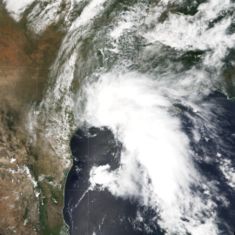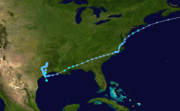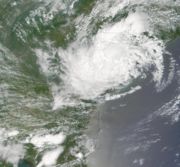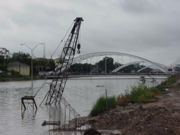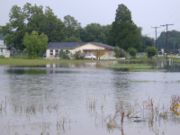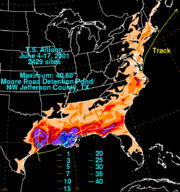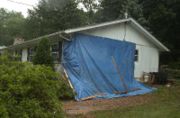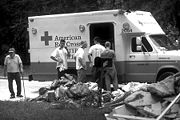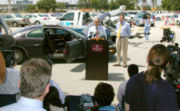Tropical Storm Allison
2008/9 Schools Wikipedia Selection. Related subjects: Storms
| Tropical storm ( SSHS) | ||
|---|---|---|
|
Tropical Storm Allison on June 5, 2001 |
||
| Formed | June 4, 2001 | |
| Dissipated | June 18, 2001 | |
| Highest winds |
|
|
| Lowest pressure | 1000 mbar ( hPa; 29.54 inHg) | |
| Fatalities | 41 direct, 14 indirect | |
| Damage | $5.5 billion (2001 USD) $6.7 billion (2008 USD) |
|
| Areas affected |
Texas (particularly around Houston), Louisiana, most of the Eastern United States | |
| Part of the 2001 Atlantic hurricane season |
||
Tropical Storm Allison was a tropical storm that devastated southeast Texas in June of the 2001 Atlantic hurricane season. The first storm of the season, Allison lasted unusually long for a June storm, remaining tropical or subtropical for 15 days. The storm developed from a tropical wave in the northern Gulf of Mexico on June 4, 2001, and struck the northern Texas coast shortly thereafter. It drifted northward through the state, turned back to the south, and re-entered the Gulf of Mexico. The storm continued to the east-northeast, made landfall on Louisiana, then moved across the southeast United States and Mid-Atlantic. Allison was the first storm since Tropical Storm Frances in 1998 to strike the northern Texas coastline.
The storm dropped heavy rainfall along its path, peaking at over 40 inches (1,000 mm) in Texas. The worst flooding occurred in Houston, where most of Allison's damage occurred: 30,000 became homeless after the flooding destroyed 2,744 homes. Downtown Houston was inundated with flooding, causing severe damage to hospitals and businesses. Twenty-three people died in Texas. Throughout its entire path, Allison caused $6.4 billion (2007 USD) in damage and 41 deaths. Aside from Texas, the places worst hit were Louisiana and southeastern Pennsylvania.
Following the storm, President George W. Bush designated 75 counties along Allison's path as disaster areas (the first time he had to do so), which enabled the citizens affected to apply for aid. Allison is the only tropical storm to have its name retired without ever having reached hurricane strength.
Storm history
A tropical wave moved off the coast of Africa on May 21. It moved westward across the shear-ridden Atlantic Ocean, retaining little convection on its way. After moving across South America and the southwestern Caribbean Sea, the wave entered the eastern North Pacific Ocean on June 1. A low-level circulation developed on June 2 while 230 miles (370 km) south-southeast of Salina Cruz, Mexico. Southerly flow forced the system northward, and the wave moved inland on June 3. The low-level circulation dissipated, though the mid-level circulation persisted. It emerged into the Gulf of Mexico on June 4, and developed deep convection on its eastern side. On June 5, the mid-level circulation extended to the surface, and organized into Tropical Storm Allison while just 140 miles (225 km) to the south of Galveston, Texas.
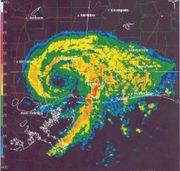
Allison initially had subtropical characteristics with an upper level low to the southwest of the circulation. Despite this, the storm quickly strengthened to a 60 mph (95 km/h) storm, though tropical storm force winds extended up to 230 miles (370 km) east of the centre. Allison weakened while nearing the Texas coastline, and struck near Freeport, Texas as a 50 mph (80 km/h) tropical storm late on June 5. The storm quickly weakened over land, and the National Hurricane Centre discontinued advisories early on June 6. The depression drifted northward until reaching Lufkin, Texas, where it stalled due to a high pressure system to its north. On June 8, the depression drifted to the south, then to the southwest. Early on June 10, Allison again reached the Gulf of Mexico just 22 miles (35 km) west of its original landfall location. Due to dry air and moderate westerly wind shear, the storm transformed into a subtropical cyclone. While the subtropical depression moved eastward, a new low level circulation redeveloped to the east, and Allison quickly made landfall on Morgan City, Louisiana on June 11. Strong thunderstorms redeveloped over the circulation, and Allison strengthened into a subtropical storm over southeastern Louisiana.
Allison re-strengthened to reach winds of 45 mph (72 km/h), and an eyewall feature briefly existed. The feature was transient, and Allison quickly weakened back to a tropical depression. The depression tracked to the east-northeast through Mississippi, Alabama, Georgia, and South Carolina before becoming nearly stationary near Wilmington, North Carolina. It drifted through the state, and accelerated to the northeast in response to an approaching cold front. Allison reached the Atlantic Ocean on June 17, and briefly reintensified to a subtropical storm through baroclinic processes. Allison became extratropical while south of Long Island on June 18, and was absorbed by the cold front on the next day.
Preparations
Shortly after the storm formed, officials in Galveston County, Texas issued a voluntary evacuation for the western end of Galveston Island, as the area was not protected by the Galveston Seawall. The ferry from the island to the Bolivar Peninsula was closed, while voluntary evacuations were issued in Surfside in Brazoria County. Voluntary evacuations were also suggested near Sabine Pass in Jefferson County, Texas, though few left. Also, when the National Hurricane Centre issued the first advisory on Allison, officials issued Tropical Storm Warnings from Sargent, Texas to Morgan City, Louisiana, just three hours before tropical storm winds were observed.
After the storm made landfall, flash flood watches and warnings were issued for numerous areas in eastern Texas. Travel was discouraged due to the threat of flash flood. During the flood event, the National Weather Service in Houston issued 99 flash flood warnings with an average lead time of 40 minutes; only nine warnings were false alarms. With an average lead time of 24 minutes, the National Weather Service in Lake Charles, Louisiana issued 47 flash flood warnings, of which eleven were false alarms. One flash flood occurred outside of the warning area. With an average lead time of 39 minutes, the National Weather Service in New Orleans/Baton Rouge issued 87 flash flood warnings, of which 30 were not followed by a flash flood. Five flash floods were not covered in the warning area.
In Tallahassee, Florida, a shelter opened the day prior to Allison's movement northward through the area, seven staff members housing 12 people. Two other shelters were on standby. Teams informed citizens in the Florida Panhandle of flood dangers.
Impact
| Area | Deaths |
|---|---|
| Texas | 23 |
| Louisiana | 1 |
| Mississippi | 1 |
| Florida | 8 |
| Virginia | 1 |
| Pennsylvania | 7 |
| Total | 41 |
Tropical Storm Allison was a major flood disaster throughout its path from Texas to the Mid-Atlantic. The worst of the flooding occurred in Houston, Texas, where over 35 inches (890 mm) of rain fell. Allison killed 41 people, of which 27 drowned. The storm also caused over $5 billion in damage (2001 USD, $6.4 billion 2007 USD), making Allison the deadliest and costliest tropical storm on record in the United States.
Texas
Allison made landfall with a storm surge of two to three feet. Combined with waves on top, areas of Galveston Island experienced a wall of water 8 feet (2.5 m) in height, creating overwash along the coastline. The storm caused winds of up to 43 mph (69 km/h) at the Galveston Pier. While Allison was stalling over Texas, it dropped heavy rainfall across the state, including 9.77 inches (248 mm) in Galveston, 12.13 inches (308 mm) in Jamaica Beach, Texas, and other similar totals along the coast. Minimal beach erosion was reported. Impact was minimal near the coast.
While moving northward through Texas as a minimal tropical depression, Allison produced minor wind gusts. Shortly after making landfall, the storm spawned a tornado in Manvel of Brazoria County, causing damage to one home. Within hours of making landfall, rainfall totals of 8 to 12 inches (200 to 300 mm) were common in Galveston and Harris County. Flash flooding continued for days, with rainfall amounts across the state peaking at just over 40 inches (1,033 mm) in northwestern Jefferson County. In the Port of Houston, a total of 36.99 inches (940 mm) was reported.
Houston experienced torrential rainfall in a short amount of time. At one site, 6.3 inches (160 mm) fell in just one hour, while 28.5 inches (724 mm) fell in only 12 hours. The six-day rainfall in Houston amounted to 38.6 inches (980 mm). Two-thirds of the bayous and creeks in Harris County experienced 500-year flood events. Houston Intercontinental Airport, which typically receives 46.07 inches (1170 mm) of rain in a year, experienced 35.7% of its expected total in the first nine days of June.
The deluge of rainfall flooded 95,000 automobiles and 73,000 houses throughout Harris County. Tropical Storm Allison destroyed 2,744 homes, leaving 30,000 homeless with residential damages totaling to $1.76 billion (2001 USD, $2.05 billion 2007 USD). Residential neighborhoods inside and to the north of Interstate 610 were hardest hit.
Several hospitals in the Texas Medical Centre, the largest medical complex in the world, experienced severe damage from the storm, which hit quickly and with unexpected fury on a Friday evening. Hospital personnel were forced to evacuate thousands of patients in a major effort that included Coast Guard and Army helicopters. Many of the hospitals had lost all power, including back-up generators, meaning that patients had to be carried down dark stairwells by the staff in temperatures over 100 °F (38 °C). Patients who could not breathe on their own had to be continuously hand-pumped during the evacuation, which lasted hours. Most hospitals lost power and backup power when basements, the area where power and research data were kept, flooded. The Baylor College of Medicine experienced major damage, totaling $495 million (2001 USD, $577 million 2007 USD). The medical school lost 90,000 research animals, 60,000 tumor samples, and 25 years of research data. The University of Texas Health Science Centre at Houston, across the street, lost thousands of laboratory animals, including expensive genetic-specific mice. Decades of research was lost, including, for many scientists, their life's work. The UT-Houston gross anatomy lab, cyclotron, and other important facilities were completely destroyed. Throughout the Medical Centre, damage totaled to over $2 billion (2001 USD, $2.3 billion 2007 USD). Most were reopened after a month, though it took much longer to become fully operational.
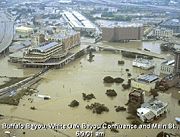
The underground tunnel system, which connects most large office buildings in downtown Houston, was submerged, as were many streets and parking garages adjacent to Buffalo Bayou. At the Theatre District, also in downtown, the Houston Symphony, Houston Grand Opera, and Alley Theatre lost millions of dollars of costumes, musical instruments, sheet music, archives and other artifacts. Local television stations ran all-night coverage of the deluge from June 8 through the next day, including KHOU-TV 11, which was forced to transmit its broadcast to a satellite truck when floodwaters entered its near-downtown production studio. By midnight June 9 nearly every freeway and major road in the city was under several feet of water, forcing hundreds of motorists to abandon their vehicles for higher ground. Eighteen-wheeled trucks were filmed floating down major freeways and highways, swept along by floodwaters.
Despite massive flooding damage to entire neighborhoods there were no drowning deaths in flooded homes. In the area, there were 12 deaths from driving, 6 from walking, 3 from electrocution, and 1 in an elevator. Elsewhere in Texas, a man drowned when swimming in a ditch in Mauriceville. Damage totaled to $5.2 billion (2001 USD, $6 billion 2007 USD) throughout Texas.
Though Allison's flooding was extreme, it was not unprecedented. Tropical Storm Amelia in 1978 dropped over 46 inches (1170 mm) of rainfall in Bluff, Texas, which remains the record highest rainfall for a single storm in the state of Texas. In addition, Tropical Storm Claudette in 1979 and a hurricane in 1921 produced rainfall totals of over 40 inches (1015 mm).
Louisiana
While making its first landfall, Allison's large circulation dropped severe rains on southwest Louisiana. Days later, Allison hit the state as a subtropical storm, dropping more heavy rains to the area. Rainfall totals peaked at 29.86 inches (758 mm) in Thibodaux, the highest rainfall total in Louisiana from a tropical cyclone since a previous Tropical Storm Allison in 1989. Most of the southeastern portion of the state experienced over 10 inches of rain (255 mm). Winds were generally light, peaking at 38 mph (61 km/h) sustained in Lakefront with gusts to 53 mph (85 km/h) in Bay Gardene. The storm produced a storm surge of 2.5 feet (0.75 m) in Cameron as it was making landfall in Texas. While moving northward through Texas, the outer bands of the storm produced an F1 tornado near Zachary, damaging several trees and a power line. A man was killed when a damaged power line hit his truck.
When Allison first made landfall, heavy rainfall flooded numerous houses and businesses. Minor wind gusts caused minor roof damage to 10 houses in Cameron Parish, while its storm surge flooded portions of Louisiana Highway 82. When the system returned, more rainfall occurred, flooding over 1,000 houses in St. Tammany Parish, 80 houses in Saint Bernard Parish, and hundreds of houses elsewhere in the state. The flooding also forced 1,800 residents from their homes in East Baton Rouge Parish. The deluge left numerous roads impassable, while runoff resulted in severe river flooding. The Bogue Falaya River in Covington crested past its peak twice to near record levels. The Amite and Comite Rivers reached their highest levels since 1983. In addition, the levee along the Bayou Manchac broke, flooding roadways and more houses. Damage in Louisiana totaled to $65 million (2001 USD, $75 million 2007 USD).
Southeast United States
In Mississippi, Allison produced heavy rainfall of over 10 inches (255 mm) in one night, while some areas in the southwestern portion of the state received over 15 inches (380 mm). The flooding damaged numerous houses and flooded many roadways. Thunderstorms from the storm produced four tornadoes, including one in Gulfport, Mississippi that damaged 10 houses. Severe thunderstorms in George County damaged 15 houses, destroyed 10, and injured five people. Damage in Mississippi totaled to over $1 million (2001 USD, $1.2 million 2007 USD). Rainfall in Alabama was moderate, with areas near Mobile experiencing more than 10 inches (255 mm). Heavy rainfall closed several roads in Crenshaw County. The storm, combined with a high pressure, produced coastal flooding in southern Alabama. Allison produced an F0 tornado in southwest Mobile County that caused minor roof damage and another F0 tornado in Covington County that caused minor damage to six homes and a church.
The storm, combined with a high pressure system, produced a strong pressure gradient, resulting in strong rip currents off the coast of Florida. The currents prompted sirens, which are normally used for storm warnings, to be activated in Pensacola Beach. The rip currents killed 5 off the coast of Florida. Outer rain bands from the storm dropped heavy rainfall across the Florida Panhandle of over 11 inches (280 mm) in one day. The Tallahassee Regional Airport recorded 10.13 inches (257 mm) in 24 hours, breaking the old 24 hour record set in 1969. Throughout the state, Allison destroyed 10 homes and damaged 599, 196 severely, primarily in Leon County. Including the deaths from rip currents, Allison killed eight people in Florida and caused $20 million (2001 USD, $23 million 2007 USD) in damage.
Over Georgia, the storm dropped heavy rainfall of 10 inches (255 mm) in 24 hours in locations. The deluge caused rivers to crest past their banks, including the Oconee River at Milledgeville which peaked at 33.7 feet (10.3 m). The rainfall, which was heaviest across the southwestern portion of the state, washed out several bridges and roads, and flooded many other roads. Georgia governor Roy Barnes declared a state of emergency for seven counties in the state. The storm also spawned two tornadoes. In South Carolina, Allison's outer bands produced 10 tornadoes and several funnel clouds, though most only caused minor damage limited to a damaged courthouse, snapped trees and downed power lines. Allison produced from 12 to 16 inches (305 to 406 mm) of rainfall in North Carolina, closing nearly all roads in Martin County and damaging 25 homes. The severe flooding washed out a bridge in eastern Halifax County and flooded numerous cars. Wet roads caused nine traffic accidents throughout the state.
Mid-Atlantic and Northeast United States
In Virginia, Allison produced light rainfall, with the southeastern and south-central portions of the state experiencing over 3 inches (76 mm). A tree in a saturated ground fell over and killed one person. Allison also produced one tornado in the state. Washington, D.C. experienced moderate rainfall from the storm, totaling to 2.59 inches (66 mm) in Georgetown. In Maryland, rainfall from Tropical Depression Allison totaled to 7.5 inches (190 mm) in Denton, closing eleven roads and causing washouts on 41 others. The Maryland Eastern Shore experienced only minor rainfall from one to two inches (25 to 50 mm). Damage was light, and no deaths were reported. In Delaware, the storm produced moderate rainfall, peaking at 4.2 inches (106 mm) in Greenwood. No damage was reported.
Allison, in combination with an approaching frontal boundary, dropped heavy rainfall across southeastern Pennsylvania, peaking at 10.17 inches (258 mm) in Chalfont in Bucks County and over 3 inches (76 mm) in portions of Philadelphia. The rainfall caused rivers to rise, with the Neshaminy Creek in Langhorne peaking at 16.87 feet (5.1 m). Several other rivers and creeks in southeastern Pennsylvania crested at over 10 feet (3 m). The rainfall downed numerous weak trees and power lines, leaving 70,000 without power during the storm. The flooding washed out several roads and bridges, including a few SEPTA rail lines. In addition, the rainfall destroyed 241 homes and damaged 1,386 others. Flooding at a Dodge dealership totaled 150 vehicles. Hundreds of people were forced to be rescued from damaged buildings from flood waters. The flooding dislodged a clothes dryer in the basement of the "A" building of the Village Green Apartment Complex in Upper Moreland Township, breaking a natural gas line. The gas leak resulted in an explosion and an ensuing fire that killed six people. Firefighters were unable to render assistance as the building was completely surrounded by floodwaters. Additionally, one man drowned in his vehicle in a river. Damage in Pennsylvania totaled to $215 million (2001 USD, $250 million 2007 USD).
In New Jersey, the storm produced heavy rainfall, peaking at 8.1 inches (205 mm) in Tuckerton. The rains also caused river flooding, including the north branch of the Metedeconk River in Lakewood which crested at 8 feet (2.5 m). The flooding, severe at places, closed several roads, including numerous state highways. Gusty winds of up to 44 mph (71 km/h) in Atlantic City downed weak trees and power lines, leaving over 13,000 without power. Several people had to be rescued from high waters, though no fatalities occurred in the state. Overall damage was minimal.
Tropical Storm Allison caused flash flooding in New York, dropping up to 3 inches (75 mm) of rain in one hour in several locations and peaking at 5.73 inches (146 mm) in Granite Springs. The rains also caused river flooding, including the Mahwah River which crested at 3.79 feet (1.2 m). Allison's rainfall damaged 24 houses and several stores, while the flooding closed several major highways in the New York City area. Overall damage was light, and no fatalities occurred in New York due to Allison. Similarly, rainfall in Connecticut peaked at 7.2 inches (183 mm) in Pomfret, closing several roads and causing minor damage to numerous houses. The Yantic River at Yantic crested at 11.1 feet (3.4 m), while a state road was closed when a private dam in Hampton failed from the rainfall. In Rhode Island, Allison produced up to 7.1 inches (180 mm) of rainfall in North Smithfield, washing out several roads and houses, and destroying a log house in Foster.
An isolated severe thunderstorm in the outer bands of Allison produced an F1 tornado in Worcester and Middlesex Counties in Massachusetts, impacting over 100 trees and damaging one house and one small camper. A microburst in Leominster and another in Shirley damaged several trees. Lightning from the storm hit two houses, causing significant damage there but little elsewhere. Allison also produced moderate rainfall in the state, mainly ranging from 3 to 5 inches (75 to 125 mm). The rainfall caused drainage and traffic problems. Damage in Massachusetts totaled to $400,000 (2001 USD, $466,000 2007 USD).
Aftermath
Within weeks of the disaster, President George W. Bush declared 28 counties in Texas, southern Louisiana, southern Mississippi, northwestern Florida, and southeastern Pennsylvania as disaster areas. The declarations allowed affected citizens to receive aid for temporary housing, emergency home repairs, and other serious disaster-related expenses. FEMA also provided 75% for the cost of debris removal, emergency services related to the disaster, and repairing or replacing damaged public facilities, such as roads, bridges and utilities.
A few weeks after Allison, FEMA opened six disaster recovery centers across southeast Texas, which provided recovery information to those who applied for disaster assistance. The American Red Cross and the Salvation Army opened 48 shelters at the peak of need for people driven from their homes, which served nearly 300,000 meals. After the extensive damage to Houston hospitals, the U. S. Public Health Service team set up a temporary hospital at the Houston Police Academy. The team of 87 medical personnel served over 1,000 patients within two weeks of Allison's passage. Similarly, the National Disaster Medical System deployed a temporary hospital to Houston with 88 professionals, aiding nearly 500 people. Debris removal, which was initially slow, was aided by FEMA to expedite the removal process. FEMA provided 75% of the federal cost of the removal. Thirty-five volunteer services provided aid for the flood victims in Texas, including food, clothing, and volunteers to help repair the houses.
After nearly 50,000 cars were flooded and ruined, many people attempted to sell the cars across the country without telling of the car's history. Following the extreme flooding, a mosquito outbreak occurred, though FEMA provided aid to control the problem. Health officials also recommended disinfecting private wells with bleach, due to possible contamination from the severe flooding. Many people took advantage of the flood victims, including fraudulent contractors and suppliers raising the price of goods more than is actually justified.
By six months after the storm, around 120,000 Texas citizens applied for federal disaster aid, totaling to $1.05 billion (2001 USD, $1.22 billion 2007 USD). 17% of that was spent for temporary housing. In addition, Disaster Unemployment Assistance totaled to just under $1 million, while business loans totaled to $389 million (2001 USD, $454 million 2007 USD).
Like in Texas, a mosquito outbreak occurred in Louisiana. Only pesticides acceptable to the US Environmental Protection Agency and the US Fish and Wildlife Service were allowed to be used. FEMA officials warned homeowners of the dangers of floodwaters, including mold, mildew, and bacteria. By three months after the storm, just under 100,000 Louisiana citizens applied for federal aid, totaling to over $110 million (2001 USD, $128 million 2007 USD). $25 million (2001 USD, $29 million 2007 USD) of the total was for business loans, while an additional $8 million was for public assistance for communities and state agencies. More than 750 flood victims in Florida applied for governmental aid, totaling to $1.29 million (2001 USD, $1.5 million 2007 USD). In Pennsylvania, 1,670 flood victims applied for federal aid, totaling to $11.5 million (2001 USD, $13.4 million 2007 USD). $3.4 million (2001 USD, $4 million 2007 USD) of the total was to replace a SEPTA rail bridge over the Sandy Run Creek in Fort Washington.
Retirement
The name Allison was retired in the spring of 2002 and will never again be used in the Atlantic basin; the 2001 incarnation of Allison is the only Atlantic tropical system to have its name retired without reaching hurricane strength. The name was replaced with Andrea in the 2007 season.
